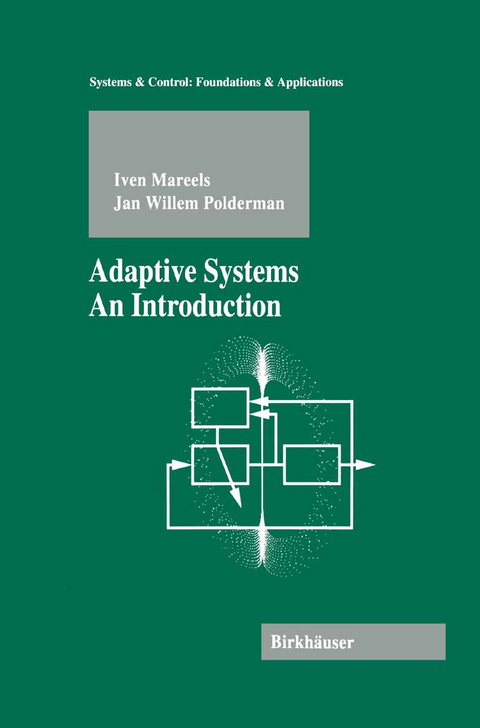
Adaptive Systems
Birkhauser Boston Inc (Verlag)
978-0-8176-3877-1 (ISBN)
1 Adaptive Systems.- 1.1 Introduction.- 1.2 Adaptive systems: examples.- 1.3 General structure of adaptive control systems.- 1.4 Illustrating the concepts.- 1.5 Summary of chapter.- 1.6 Notes and references.- 1.7 Exercises.- 2 Systems And Their Representations.- 2.1 Introduction.- 2.2 Notation.- 2.3 The behavior.- 2.4 Latent variables.- 2.5 Equivalent representations.- 2.6 Controllability.- 2.7 Observability.- 2.8 Stability.- 2.9 Elimination of Latent variables.- 2.10 The ring ?[?,??1].- 2.11 An example.- 2.12 A word about the notation.- 2.13 Summary of chapter.- 2.14 Notes and references.- 3 Adaptive systems : principles of identification.- 3.1 Introduction.- 3.2 Object of interest and model class.- 3.3 Identification criterion and algorithms.- 3.4 Data model assumptions.- 3.5 Analysis of identification algorithms.- 3.6 Persistency of excitation.- 3.7 Summary of chapter.- 3.8 Notes and references.- 3.9 Exercises.- 4 Adaptive Pole Assignment.- 4.1 Introduction.- 4.2 Preliminaries.- 4.3 The system and its representations.- 4.4 Equilibrium analysis.- 4.5 An algorithm for adaptive pole assignment.- 4.6 Analysis of the algorithm.- 4.7 Filtered signals.- 4.8 Modification of the projection algorithm.- 4.9 Summary of chapter.- 4.10 Notes and references.- 4.11 Exercises.- 5 Direct Adaptive Model Reference Control.- 5.1 Introduction.- 5.2 Basic problem definition.- 5.3 Model reference control: nonadaptive solution.- 5.4 Error model construction.- 5.5 Equilibrium analysis.- 5.6 Adaptive algorithm.- 5.7 Analysis of the adaptive system.- 5.8 Adaptive model reference control with disturbance rejection.- 5.9 Summary of chapter.- 5.10 Notes and references.- 5.11 Exercises.- 6 Universal Controllers.- 6.1 Introduction.- 6.2 Existence of solutions.- 6.3 The first order case.- 6.4Higher order systems.- 6.5 Mårtensson’s algorithm.- 6.6 Summary of chapter.- 6.7 Notes and references.- 6.8 Exercises.- 7 The pole/zero cancellation problem.- 7.1 Introduction.- 7.2 The pole/zero cancellation problem in adaptive control.- 7.3 Combining direct and indirect adaptive control.- 7.4 Adaptive Excitation.- 7.5 A more fundamental viewpoint.- 7.6 Conclusions.- 7.7 Summary of chapter.- 7.8 Notes and references.- 7.9 Exercises.- 8 Averaging Analysis For Adaptive Systems.- 8.1 Introduction.- 8.2 Averaging.- 8.3 Transforming an adaptive system into standard form.- 8.4 Averaging approximation.- 8.5 Application: the MIT rule for adaptive control.- 8.6 Application: echo cancellation in telephony.- 8.7 Summary of chapter.- 8.8 Notes and references.- 8.9 Exercises.- 9 Dynamics of adaptive systems: A case study.- 9.1 Introduction.- 9.2 The example.- 9.3 Global analysis and bifurcations.- 9.4 Adaptive system behavior: ideal case.- 9.5 Adaptive system behavior: undermodelled case.- 9.6 Discussion.- 9.7 Summary of chapter.- 9.8 Notes and References.- 9.9 Exercises.- Epilogue.- A Background material.- A.1 A contraction result.- A.2 The Comparison Principle.- A.2.1 Bellman-Gronwall Lemma.- A.2.2 Perturbed linear stable systems.- A.3 Miscellaneous stability results.- A.3.1 Stability Definitions.- A.3.2 Some Lyapunov stability results.- A.4 Detectability.- A.5 An inequality for linear systems.- A.6 Finite horizon averaging result.- A.7 Maple code for solving Lyapunov equations.- A.8 Maple code for fixed points and two periodic solutions.
| Erscheint lt. Verlag | 30.7.1996 |
|---|---|
| Reihe/Serie | Systems & Control: Foundations & Applications |
| Zusatzinfo | XVII, 342 p. |
| Verlagsort | Secaucus |
| Sprache | englisch |
| Maße | 155 x 235 mm |
| Themenwelt | Mathematik / Informatik ► Informatik ► Theorie / Studium |
| Mathematik / Informatik ► Mathematik | |
| Technik ► Elektrotechnik / Energietechnik | |
| ISBN-10 | 0-8176-3877-6 / 0817638776 |
| ISBN-13 | 978-0-8176-3877-1 / 9780817638771 |
| Zustand | Neuware |
| Informationen gemäß Produktsicherheitsverordnung (GPSR) | |
| Haben Sie eine Frage zum Produkt? |
aus dem Bereich


